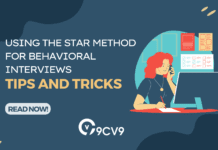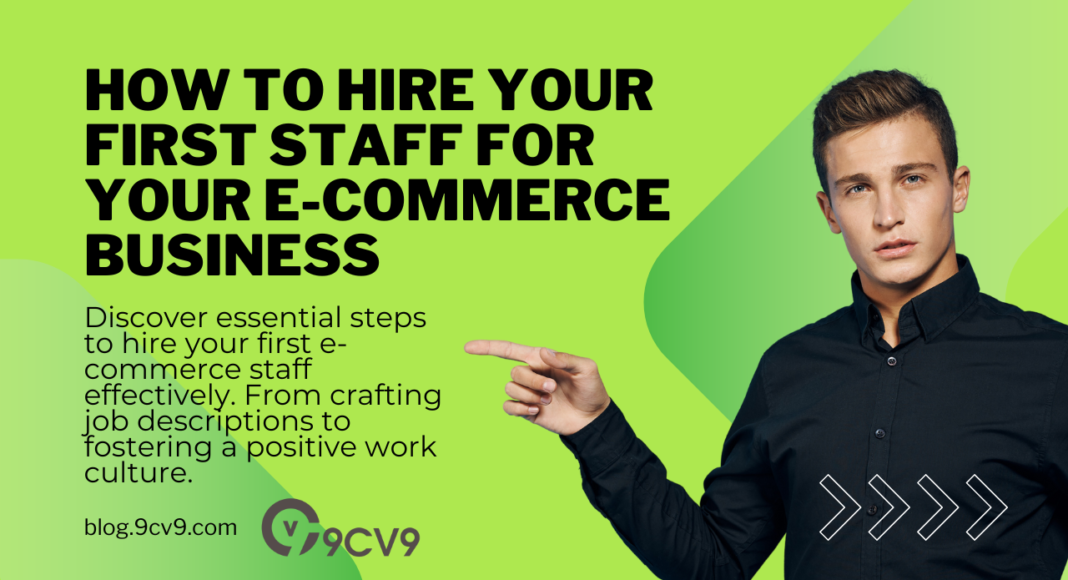Key Takeaways
- Craft compelling job descriptions: Capture top talent by outlining clear roles, responsibilities, and company culture in your job postings.
- Prioritize cultural fit: Look beyond skills to ensure new hires align with your company values, fostering a positive work environment.
- Invest in onboarding and training: Set your team up for success with structured onboarding programs and ongoing training opportunities to nurture growth.
In the bustling world of e-commerce, where every click counts and customer satisfaction reigns supreme, the backbone of your operation lies in the hands of your team.
As an e-commerce entrepreneur, venturing into the realm of hiring your first staff marks a pivotal moment in your business journey.
It’s not just about finding individuals to fill roles; it’s about assembling a passionate, skilled, and dedicated team that will propel your e-commerce venture to new heights of success.
But embarking on the hiring process can feel like navigating uncharted waters, especially when it’s your first time at the helm.
The questions swirl: Where do I even begin? How do I attract top talent? What qualities should I look for in potential candidates? How do I ensure a seamless onboarding process?
Fear not, for this guide is your compass, your roadmap, and your trusted companion as you embark on the journey to hiring your first staff for your e-commerce business.
First and foremost, it’s essential to recognize the pivotal role that your team plays in the success of your e-commerce venture.
From handling customer inquiries and managing inventory to optimizing your website for conversions and executing marketing strategies, your staff are the engine that keeps your business running smoothly.
They are the frontline ambassadors of your brand, embodying its values and forging meaningful connections with your customers.
But building a stellar team isn’t just about finding warm bodies to fill seats; it’s about finding the right people with the right skills, mindset, and cultural fit to drive your business forward.
This process begins with a deep understanding of your business needs and objectives.
Take stock of your current workload, identify pain points, and pinpoint areas where additional support is needed.
Are you struggling to keep up with order fulfillment?
Do you need help with social media management?
By defining clear roles and responsibilities, you can hone in on the specific skill sets and expertise required for each position.
With your needs clearly outlined, the next step is to craft compelling job descriptions that will attract top talent.
Think of your job description as your first impression – it should be concise, engaging, and informative.
Outline the key responsibilities of the role, highlight any desired qualifications or experience, and showcase your company culture and values.
Use language that resonates with your target audience and sets your job listing apart from the competition.
Once your job descriptions are polished and ready to go, it’s time to cast your net and start sourcing candidates.
In today’s digital age, there is no shortage of avenues for finding talent, from traditional job boards and recruitment agencies to social media platforms and professional networks.
Consider leveraging industry-specific forums and communities to connect with candidates who have a passion for e-commerce and a deep understanding of your niche.
As the applications start rolling in, it’s crucial to have a structured screening process in place to efficiently review resumes and identify top contenders.
Look beyond the bullet points on a CV and consider factors such as cultural fit, attitude, and potential for growth.
Conducting thorough interviews – whether in person or virtually – will help you gauge a candidate’s personality, communication skills, and problem-solving abilities, providing valuable insights into their suitability for the role.
But hiring your first staff is just the beginning – the real work begins once they’re on board.
A robust onboarding process is essential for setting clear expectations, introducing new hires to your company culture, and equipping them with the tools and knowledge they need to hit the ground running.
Provide comprehensive training, assign mentors or buddies for support, and foster an environment of open communication and feedback to ensure that your new staff feel valued and empowered from day one.
Beyond the nuts and bolts of recruitment and onboarding lies the heart of building a successful team: cultivating a positive work culture.
Your team is more than just a collection of individuals – they are a community, united by a shared vision and a passion for your brand.
Foster a supportive and inclusive environment where ideas are valued, collaboration is encouraged, and achievements are celebrated.
By investing in your team’s well-being and professional development, you lay the foundation for long-term success and sustainability.
Hiring your first staff for your e-commerce business is a significant milestone that should not be taken lightly.
It requires careful planning, thoughtful consideration, and a commitment to finding the best talent to drive your business forward.
By following the steps outlined in this guide – from defining your needs and crafting compelling job descriptions to sourcing candidates and fostering a positive work culture – you can set yourself up for success and build a team that will help you achieve your e-commerce goals.
So, arm yourself with knowledge, trust in your instincts, and embark on this exciting journey with confidence. Your dream team awaits.
Before we venture further into this article, we like to share who we are and what we do.
About 9cv9
9cv9 is a business tech startup based in Singapore and Asia, with a strong presence all over the world.
With over eight years of startup and business experience, and being highly involved in connecting with thousands of companies and startups, the 9cv9 team has listed some important learning points in this overview of How to Hire Your First Staff For Your E-Commerce Business.
If your company needs recruitment and headhunting services to hire top-quality employees, you can use 9cv9 headhunting and recruitment services to hire top talents and candidates. Find out more here, or send over an email to [email protected].
Or just post 1 free job posting here at 9cv9 Hiring Portal in under 10 minutes.
How to Hire Your First Staff For Your E-Commerce Business
- Understanding Your Business Needs
- Crafting Compelling Job Descriptions
- Where to Find Talent
- Screening and Selecting Candidates
- Onboarding and Training Your New Staff
- Building a Positive Work Culture
1. Understanding Your Business Needs
Before diving headfirst into the hiring process, it’s essential to take a step back and assess your e-commerce business’s current state and future goals.

Understanding your business needs lays the groundwork for identifying the roles and skill sets required for your first staff members. Let’s delve into this crucial aspect in detail:
Assessing Workload and Identifying Pain Points
- Review Current Workload: Conduct a comprehensive analysis of your daily operations, including order processing, customer service, marketing efforts, and administrative tasks.
- Example: If you find yourself spending hours manually updating product listings and processing orders, it may be time to consider hiring someone to manage inventory and streamline the fulfillment process.
- Identify Pain Points: Pinpoint areas where you or your existing team members are stretched thin or struggling to keep up.
- Example: You might notice that customer inquiries are piling up, leading to delayed responses and potential loss of sales. This could indicate a need for additional customer support staff to handle inquiries promptly.
Defining Roles and Responsibilities
- Clarify Business Objectives: Clearly outline your short-term and long-term business goals to align hiring decisions with your overall strategy.
- Example: If your goal is to expand into new markets, you might need to hire a digital marketing specialist with experience in SEO, PPC advertising, and social media management.
- Identify Key Areas of Focus: Determine which areas of your business require immediate attention and support.
- Example: If your e-commerce platform experiences frequent technical issues or requires regular updates, hiring a web developer or IT specialist could be a priority.
Determining Required Skills and Qualities
- Technical Expertise: Identify specific technical skills needed to perform job duties effectively.
- Example: For roles involving website management and optimization, proficiency in platforms like Shopify, WooCommerce, or Magento may be essential.
- Soft Skills and Attributes: Consider the personality traits and soft skills that align with your company culture and values.
- Example: In a fast-paced e-commerce environment, candidates who demonstrate adaptability, problem-solving abilities, and a customer-centric mindset may thrive.
Example Scenario: Hiring for Customer Service Role
- Assessing Workload: You notice a significant increase in customer inquiries via email and social media platforms, leading to delayed responses and declining customer satisfaction scores.
- Defining Roles and Responsibilities: You decide to hire a customer service representative to handle incoming inquiries, resolve issues, and ensure a positive customer experience.
- Determining Required Skills and Qualities: You prioritize candidates with excellent communication skills, empathy, and the ability to multitask in a fast-paced environment.
- Technical Expertise: While specific software proficiency may vary, familiarity with customer relationship management (CRM) tools and e-commerce platforms is advantageous.
By thoroughly understanding your e-commerce business needs, you can pinpoint areas for improvement and strategically allocate resources to support growth and success.
This foundational step sets the stage for crafting compelling job descriptions and effectively recruiting top talent to join your team.
2. Crafting Compelling Job Descriptions
Crafting compelling job descriptions is the cornerstone of attracting top talent to your e-commerce business.
A well-written job description not only outlines the responsibilities of the role but also showcases your company culture and values.
Let’s explore the essential elements of crafting job descriptions that stand out and attract the right candidates:
Clear and Concise Job Titles
- Be Specific: Choose a job title that accurately reflects the role’s duties and level of responsibility.
- Example: Instead of “Customer Service Representative,” opt for “E-commerce Customer Support Specialist” to convey the role’s focus within the e-commerce context.
- Include Keywords: Incorporate relevant keywords that candidates are likely to search for when browsing job listings online.
- Example: If you’re hiring for a marketing role, include terms like “digital marketing,” “SEO,” or “content creation” to improve search visibility.
Detailed Job Responsibilities
- Outline Key Duties: Clearly articulate the primary responsibilities and tasks associated with the role.
- Example: “Manage customer inquiries via email, chat, and social media platforms, providing timely and personalized responses to ensure a positive customer experience.”
- Highlight Key Projects: Mention any specific projects or initiatives the candidate will be involved in to give them a sense of the role’s impact and significance.
- Example: “Lead the development and execution of email marketing campaigns to drive customer engagement and increase sales conversions.”
Required Qualifications and Skills
- Technical Skills: Specify any technical skills or certifications required to perform the job effectively.
- Example: “Proficiency in e-commerce platforms such as Shopify or Magento, with experience managing product listings, inventory, and order fulfillment.”
- Soft Skills: Highlight desirable soft skills and attributes that contribute to success in the role.
- Example: “Excellent communication skills, with the ability to empathize with customers, resolve issues efficiently, and maintain professionalism in all interactions.”
Company Culture and Values
- Showcase Your Culture: Provide insight into your company’s culture, values, and work environment to attract candidates who align with your ethos.
- Example: “Join a dynamic team passionate about delivering exceptional customer experiences and driving innovation in the e-commerce industry.”
- Highlight Perks and Benefits: Mention any unique perks, benefits, or opportunities for growth and development to entice candidates.
- Example: “Enjoy flexible remote work options, competitive salary, and opportunities for advancement in a rapidly growing e-commerce startup.”
Example Job Description: E-commerce Marketing Specialist
Job Title: E-commerce Marketing Specialist
Responsibilities:
- Develop and execute comprehensive digital marketing strategies to drive traffic, increase brand awareness, and generate sales for our e-commerce platform.
- Manage all aspects of digital advertising campaigns, including PPC, display advertising, and retargeting efforts, to optimize ROI and maximize conversions.
- Conduct ongoing analysis of marketing performance metrics and make data-driven recommendations to improve campaign effectiveness and drive revenue growth.
- Collaborate with cross-functional teams to develop engaging content, promotional offers, and marketing initiatives that resonate with our target audience.
- Stay informed of industry trends and best practices, leveraging emerging technologies and platforms to innovate our marketing approach.
Qualifications:
- Bachelor’s degree in Marketing, Communications, or related field.
- 2+ years of experience in digital marketing, preferably in an e-commerce or retail environment.
- Proficiency in Google Analytics, Google Ads, and other digital marketing tools.
- Strong analytical skills with the ability to interpret data and generate actionable insights.
- Excellent written and verbal communication skills, with a creative flair for crafting compelling marketing messages.
Company Culture: Join a dynamic team dedicated to revolutionizing the e-commerce landscape through innovation, collaboration, and a passion for exceeding customer expectations. Enjoy a flexible work environment, competitive salary, and opportunities for career growth and advancement.
By crafting job descriptions that effectively communicate the role’s responsibilities, qualifications, and company culture, you can attract qualified candidates who are eager to contribute to your e-commerce business’s success.
These descriptions serve as a valuable tool for attracting top talent and setting clear expectations for prospective hires.
3. Where to Find Talent
Finding the right talent for your e-commerce business is essential for its success.
From traditional job boards to specialized platforms and networking events, there are various avenues to explore when seeking out potential candidates.

Let’s explore some effective strategies and resources for finding talent to hire your first staff members:
Utilizing Job Boards
- General Job Boards: Post your job openings on popular general job boards like 9cv9 where candidates from diverse backgrounds may be actively searching for opportunities.
- Example: Indeed, Glassdoor, 9cv9
- Niche Job Boards: Explore specialized job boards catering specifically to e-commerce, digital marketing, or relevant industries to target candidates with relevant skills and experience.
Leveraging Social Media Platforms
- LinkedIn: Utilize LinkedIn’s powerful networking capabilities to connect with professionals in your industry and share job postings with your network.
- Example: Join relevant LinkedIn groups and participate in discussions to engage with potential candidates.
- Facebook Groups: Join e-commerce or industry-specific Facebook groups where professionals gather to share insights, resources, and job opportunities.
- Example: “E-commerce Entrepreneurs Network,” “Digital Marketing Professionals Community”
Tapping Into Professional Networks
- Networking Events: Attend industry conferences, meetups, and networking events to connect with professionals and expand your talent pool.
- Example: Attend e-commerce conferences like IRCE, eTail, or ShopTalk to meet potential candidates and learn about the latest trends in the industry.
- Referrals: Encourage referrals from your existing network, employees, and industry contacts to tap into trusted recommendations and connections.
- Example: Use the Jobsrefer Portal to offer referral bonuses or incentives to employees who refer candidates who are hired and successfully onboarded.
Exploring Freelance Platforms
- Freelance Websites: Explore freelance platforms where you can find independent contractors and freelancers specializing in various e-commerce-related roles.
- Example: Upwork, Freelancer, Fiverr
- Gig Economy Platforms: Consider platforms that cater to the gig economy, where you can find on-demand talent for short-term projects or temporary roles.
- Example: TaskRabbit, Gigster, Thumbtack
Engaging with Industry-Specific Communities
- Online Forums and Communities: Participate in online forums and communities dedicated to e-commerce, digital marketing, and related topics to engage with professionals and share job opportunities.
- Example: Reddit communities like r/ecommerce, r/digitalmarketing, or specialized forums like Warrior Forum.
- Industry Associations: Explore industry associations and professional organizations related to e-commerce and digital marketing, where you can connect with professionals and access job boards or career resources.
- Example: Ecommerce Foundation, Digital Marketing Association
Example Strategy: Utilizing LinkedIn for Talent Acquisition
- Optimize Your LinkedIn Profile: Ensure your company’s LinkedIn profile is complete and optimized with relevant keywords to improve visibility in search results.
- Post Job Openings: Use LinkedIn’s job posting feature to advertise your job openings to a targeted audience of professionals in your industry.
- Engage with Professionals: Actively engage with professionals in your network by sharing industry insights, participating in discussions, and showcasing your company culture.
- Utilize LinkedIn Groups: Join and participate in LinkedIn groups relevant to e-commerce, digital marketing, and your industry niche to connect with potential candidates.
- Direct Outreach: Leverage LinkedIn’s messaging feature to reach out directly to professionals who match your desired qualifications and express your interest in potential opportunities.
By leveraging a combination of these strategies and resources, you can effectively expand your talent pool and connect with qualified candidates who are passionate about contributing to the success of your e-commerce business.
Whether you’re posting job openings on job boards, engaging with professionals on social media, or networking at industry events, casting a wide net and utilizing targeted approaches will increase your chances of finding the right talent for your team.
4. Screening and Selecting Candidates
Screening and selecting candidates for your e-commerce business is a critical step in building a high-performing team that will drive your company’s success.
By implementing a structured and thorough selection process, you can identify candidates who not only possess the necessary skills and experience but also align with your company culture and values.
Let’s explore some effective strategies and best practices for screening and selecting candidates:
Developing a Screening Process
- Review Resumes and Applications: Begin by carefully reviewing resumes and job applications to assess candidates’ qualifications, experience, and skills.
- Example: Look for relevant experience in e-commerce, digital marketing, customer service, or other areas critical to your business.
- Screening Questions: Develop a set of screening questions to gather additional information from candidates and assess their suitability for the role.
- Example: Ask candidates about their experience working with e-commerce platforms, their approach to customer service, or their familiarity with specific tools or software.
- Phone Screening Interviews: Conduct initial phone screening interviews to further evaluate candidates’ qualifications, communication skills, and interest in the role.
- Example: Use this opportunity to ask candidates about their career goals, relevant experiences, and availability for interviews.
Conducting In-Depth Interviews
- Behavioral Interviews: Conduct behavioral interviews to assess candidates’ past behavior and experiences, which can provide valuable insights into their skills and fit for the role.
- Example: Ask candidates to provide specific examples of how they handled challenging situations or achieved success in previous roles.
- Technical Assessments: Administer technical assessments or skills tests to evaluate candidates’ proficiency in areas relevant to the role.
- Example: For a web developer role, you might ask candidates to complete a coding challenge or demonstrate their knowledge of HTML, CSS, and JavaScript.
- Case Studies or Role-Playing Exercises: Present candidates with case studies or role-playing exercises to simulate real-world scenarios and evaluate their problem-solving abilities and decision-making skills.
- Example: Ask candidates to analyze a hypothetical e-commerce marketing campaign or handle a customer service scenario.
Assessing Cultural Fit
- Company Values Alignment: Assess candidates’ alignment with your company’s values, culture, and work environment to ensure they will thrive and contribute positively to your team.
- Example: Inquire about candidates’ work preferences, communication styles, and attitudes toward collaboration and teamwork.
- Team Dynamics: Consider how candidates’ personalities and working styles will complement existing team dynamics and contribute to a positive and productive work environment.
- Example: Look for candidates who demonstrate a willingness to learn, adapt, and collaborate with others to achieve common goals.
Example Selection Process: E-commerce Customer Support Representative
- Resume Review: Review resumes to identify candidates with experience in customer service, preferably in an e-commerce or retail environment.
- Phone Screening: Conduct phone screening interviews to assess candidates’ communication skills, problem-solving abilities, and interest in providing excellent customer service.
- Behavioral Interview: Conduct in-depth behavioral interviews to evaluate candidates’ past experiences and their approach to handling customer inquiries and resolving issues.
- Technical Assessment: Administer a technical assessment or skills test to evaluate candidates’ ability to navigate e-commerce platforms, manage customer databases, and respond to customer inquiries effectively.
- Culture Fit Assessment: Assess candidates’ alignment with your company’s values and culture through questions about their work preferences, communication style, and attitudes toward teamwork.
By implementing a comprehensive screening and selection process, you can identify candidates who not only possess the necessary skills and qualifications but also align with your company’s values and culture.
This approach ensures that you build a cohesive and high-performing team that will drive your e-commerce business forward and deliver exceptional results.
5. Onboarding and Training Your New Staff
Onboarding and training your new staff members are crucial steps in setting them up for success and integrating them seamlessly into your e-commerce business.
A well-planned onboarding process not only helps new hires acclimate to their roles but also fosters a sense of belonging and engagement within your team.
Let’s explore some effective strategies and best practices for onboarding and training your new staff:
Creating a Structured Onboarding Program
- Welcome Package: Prepare a welcome package or email to greet new hires and provide them with essential information about your company, its mission, values, and culture.
- Example: Include a welcome letter from the CEO, an organizational chart, and details about company policies and procedures.
- Introduction to Team: Facilitate introductions between new hires and their team members to help them feel welcome and build relationships from day one.
- Example: Organize a virtual meet-and-greet session or team lunch to allow new hires to get to know their colleagues.
- Training Schedule: Develop a training schedule outlining the topics, modules, and timelines for onboarding activities and training sessions.
- Example: Allocate time for orientation sessions, role-specific training, and shadowing opportunities with experienced team members.
Providing Role-Specific Training
- Job Duties and Responsibilities: Clearly communicate new hires’ roles, responsibilities, and performance expectations to ensure they understand what is expected of them.
- Example: Provide detailed job descriptions and walkthroughs of common tasks and workflows related to their role.
- Tools and Systems: Familiarize new hires with the tools, software, and systems they will use in their day-to-day work, such as e-commerce platforms, CRM software, and communication tools.
- Example: Offer hands-on training sessions or video tutorials to demonstrate how to navigate and utilize these tools effectively.
- Best Practices and Processes: Share best practices, standard operating procedures (SOPs), and workflows relevant to their role to help new hires perform their duties efficiently and effectively.
- Example: Provide documentation or training materials outlining how to handle customer inquiries, process orders, and troubleshoot common issues.
Offering Ongoing Support and Feedback
- Mentorship Program: Pair new hires with experienced team members or mentors who can provide guidance, support, and feedback throughout the onboarding process.
- Example: Assign a buddy system where new hires can shadow their mentor, ask questions, and receive personalized assistance.
- Regular Check-Ins: Schedule regular check-in meetings with new hires to assess their progress, address any concerns or challenges, and provide constructive feedback.
- Example: Conduct weekly or bi-weekly one-on-one meetings to discuss performance, goals, and areas for improvement.
- Encouraging Open Communication: Create a culture of open communication and transparency where new hires feel comfortable asking questions, seeking clarification, and sharing feedback.
- Example: Foster an environment where team members are encouraged to provide feedback and suggestions for process improvement during team meetings or brainstorming sessions.
Example Onboarding Process: E-commerce Customer Support Representative
- Welcome Package: Send a welcome email to new hires containing a welcome letter, company handbook, and details about their first day and orientation schedule.
- Team Introduction: Introduce new hires to their team members through a virtual meet-and-greet session or team lunch.
- Training Schedule: Provide a detailed training schedule outlining orientation sessions, role-specific training modules, and shadowing opportunities.
- Role-Specific Training: Conduct training sessions on handling customer inquiries, using the customer support software, and adhering to company policies and procedures.
- Ongoing Support: Assign a mentor to new hires who can provide guidance and support throughout the onboarding process and beyond.
- Regular Check-Ins: Schedule bi-weekly check-in meetings with new hires to assess their progress, address any concerns, and provide feedback on performance.
By implementing a structured onboarding and training program, you can ensure that your new staff members feel supported, empowered, and equipped with the knowledge and skills they need to excel in their roles.
Investing time and resources in onboarding and training pays dividends in the long run, leading to higher employee satisfaction, productivity, and retention rates within your e-commerce business.
6. Building a Positive Work Culture
Building a positive work culture is essential for fostering a supportive and motivating environment where employees feel valued, engaged, and empowered.
A strong work culture not only enhances employee morale and satisfaction but also contributes to higher productivity, collaboration, and overall business success.

Let’s explore some effective strategies and best practices for building a positive work culture within your e-commerce business:
Defining Core Values and Mission
- Identify Core Values: Define the core values that represent the beliefs, principles, and behaviors you want to cultivate within your organization.
- Example: If customer satisfaction is paramount to your e-commerce business, one of your core values might be “Customer-Centricity.”
- Communicate Mission Statement: Articulate a clear and compelling mission statement that reflects your company’s purpose, vision, and goals.
- Example: “Empowering businesses to thrive in the digital marketplace by delivering innovative e-commerce solutions and exceptional customer experiences.”
Leading by Example
- Leadership Behavior: Lead by example and embody the values and behaviors you want to see in your team members.
- Example: Demonstrate a commitment to excellence, integrity, and continuous improvement in your own work and interactions with others.
- Transparent Communication: Foster open and transparent communication with your team members, keeping them informed about company goals, initiatives, and challenges.
- Example: Hold regular town hall meetings or virtual Q&A sessions where employees can ask questions, share feedback, and voice concerns.
Encouraging Collaboration and Teamwork
- Cross-Functional Collaboration: Encourage collaboration and teamwork across departments and teams to foster innovation and collective problem-solving.
- Example: Create cross-functional project teams to tackle business challenges or launch new initiatives, bringing together diverse perspectives and expertise.
- Recognition and Appreciation: Recognize and celebrate team achievements and individual contributions to reinforce a culture of collaboration and appreciation.
- Example: Implement an employee recognition program or “kudos” board where team members can acknowledge each other’s accomplishments publicly.
Supporting Work-Life Balance
- Flexible Work Arrangements: Offer flexible work arrangements, such as remote work options or flexible hours, to accommodate employees’ personal and professional commitments.
- Example: Allow employees to set their own schedules or work remotely part-time to better balance work and family responsibilities.
- Wellness Initiatives: Implement wellness initiatives and programs to support employees’ physical, mental, and emotional well-being.
- Example: Offer virtual yoga classes, meditation sessions, or wellness challenges to promote healthy habits and reduce stress.
Emphasizing Growth and Development
- Learning Opportunities: Provide opportunities for continuous learning and development through training programs, workshops, and skill-building initiatives.
- Example: Offer access to online courses, webinars, or certifications relevant to employees’ roles and career aspirations.
- Career Pathing: Support employees in their career growth and advancement by providing clear pathways for progression and advancement within the organization.
- Example: Create individual development plans and regular performance reviews to discuss career goals, skill gaps, and opportunities for growth.
By prioritizing the development of a positive work culture, your e-commerce business can create an environment where employees feel inspired, motivated, and empowered to contribute their best work.
Investing in building a strong work culture not only enhances employee satisfaction and retention but also drives business performance and long-term success.
Conclusion
In conclusion, embarking on the journey to hire your first staff for your e-commerce business marks a significant milestone in your entrepreneurial endeavors.
As you navigate through the intricacies of recruitment, onboarding, and fostering a positive work culture, it’s crucial to keep sight of the overarching goal: building a team that will propel your business to new heights of success.
Throughout this comprehensive guide, we’ve explored a myriad of strategies, techniques, and best practices to help you navigate the hiring process with confidence and clarity.
From understanding your business needs and crafting compelling job descriptions to screening candidates, onboarding new hires, and building a positive work culture, each step plays a pivotal role in shaping the trajectory of your e-commerce venture.
By defining your business needs and identifying the skills and qualities required for each role, you can attract top talent that aligns with your company’s vision and values.
Crafting compelling job descriptions that showcase your company culture and opportunities for growth ensures that you capture the attention of qualified candidates in a competitive hiring landscape.
Once you’ve identified potential candidates, implementing a structured screening and selection process allows you to assess their qualifications, experience, and cultural fit effectively.
Through thoughtful onboarding and training programs, you can set your new hires up for success and facilitate their integration into your team seamlessly.
Building a positive work culture is not just about perks and benefits—it’s about creating an environment where employees feel valued, supported, and inspired to do their best work.
By fostering open communication, encouraging collaboration, supporting work-life balance, and prioritizing growth and development, you can cultivate a culture that attracts and retains top talent.
As you embark on this transformative journey of hiring your first staff for your e-commerce business, remember that building a dream team takes time, effort, and dedication.
Embrace the challenges and opportunities that come your way, and never underestimate the power of investing in your people.
In the dynamic and ever-evolving world of e-commerce, your team is your greatest asset.
By following the insights and strategies outlined in this guide, you can build a team that not only meets your business needs but also drives innovation, fosters growth, and propels your e-commerce business to unprecedented levels of success.
So, equip yourself with knowledge, trust in your instincts, and embark on this exciting journey with confidence. Your dream team awaits, ready to conquer the world of e-commerce together.
If your company needs HR, hiring, or corporate services, you can use 9cv9 hiring and recruitment services. Book a consultation slot here, or send over an email to [email protected].
If you find this article useful, why not share it with your hiring manager and C-level suite friends and also leave a nice comment below?
We, at the 9cv9 Research Team, strive to bring the latest and most meaningful data, guides, and statistics to your doorstep.
To get access to top-quality guides, click over to 9cv9 Blog.
People Also Ask
How do I know when it’s time to hire my first staff for my e-commerce business?
If you’re overwhelmed with tasks, experiencing growth, or struggling to meet customer demands, it’s likely time to consider hiring your first staff member.
What positions should I prioritize when hiring for my e-commerce business?
Start by focusing on roles crucial to your operations, such as customer support, order fulfillment, and digital marketing, to ensure smooth business functioning.
How can I ensure I hire the right candidate for my e-commerce business?
Define clear job roles, conduct thorough interviews, assess cultural fit, and consider relevant experience and skills to ensure the candidate aligns with your business needs.
What qualities should I look for in potential hires for my e-commerce startup?
Look for candidates who demonstrate adaptability, strong communication skills, a customer-centric mindset, and a willingness to learn and grow within your company.
How should I craft job descriptions to attract the right candidates?
Be specific about job duties, highlight company culture and values, include relevant keywords, and showcase opportunities for growth and development in your job postings.
What are some effective strategies for onboarding new staff members in my e-commerce business?
Develop a structured onboarding program, assign mentors, provide role-specific training, and foster open communication to help new hires integrate smoothly into your team.
How can I foster a positive work culture in my e-commerce startup?
Lead by example, prioritize communication and collaboration, support work-life balance, recognize and appreciate employee contributions, and provide opportunities for growth and development.































![Writing A Good CV [6 Tips To Improve Your CV] 6 Tips To Improve Your CV](https://blog.9cv9.com/wp-content/uploads/2020/06/2020-06-02-2-100x70.png)


